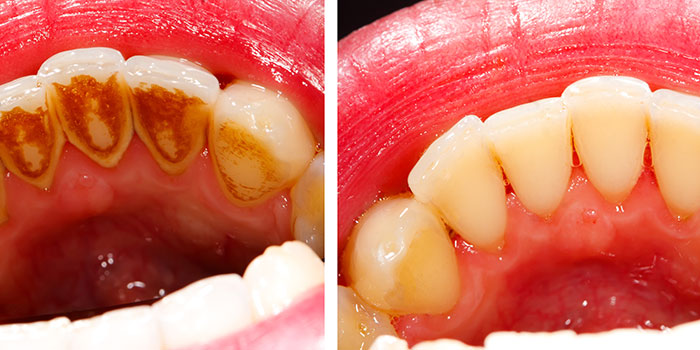July 8, 2019
Many patients ask our dentists about the difference between plaque and tartar. It is an important question. Even more important for your oral health is to know how to remove dental plaque. For this reason, we talked to our dentists and asked them to explain what you can do to remove build-up plaque.
What is dental plaque?
Dental plaque is a dental biofilm which is soft and extremely sticky. It is colourless or can show as a pale-yellow shading on your teeth. Plaque forms when saliva, fluids and food particles feed bacteria in your mouth. These bacteria deposits cling to your teeth, especially along the gum line, and then produce acid that attacks your tooth enamel.
To remove this layer of plaque while it is soft, it is essential to brush your teeth twice daily for at least two minutes. Flossing helps to remove the sticky film close to the gum line where most of the plaque accumulates. If you don’t remove plaque by brushing and flossing your teeth, it hardens (mineralises), can trap stains and turn into tartar. This can damage your teeth, lead to decay and even cause gum disease. Plaque is also one of the main causes for bad breath.
What is tartar?
Tartar, also known as dental calculus, builds up if plaque has accumulated and hardened on your teeth due to a lack of oral hygiene routine. It has a darker colour than plaque varying from a yellow to brownish deposit on your teeth. Tartar can also trap stains on your teeth which lead to tooth discolouration.
Unlike plaque, you won’t be able to remove tartar with a toothbrush or floss. It is stuck to your tooth’s enamel and you will need your dentist’s help to remove it.
As we get older, our teeth become more prone to tartar build-up. People who have braces, smoke, or have dry mouth are also at a higher risk of developing dental calculus.
How can you reduce dental plaque?
Dental plaque feeds on bacteria that arises when food and drinks are combined with saliva. Certain types of food contribute to a higher growth of bacteria. Especially items that are high in carbohydrates, sugar and starches increase plaque formation. This includes milk, soft drinks, candy, cakes, and fruit.
If particles of these foods are left on your teeth, it contributes to the growth of plaque and an increase of acid. The acid then destroys your tooth enamel which can result in tooth decay.
To reduce plaque, stick to a balanced diet and limit the amount of snacks you have. Choose your snacks wisely and try to stick to options low in sugar such as plain yogurt, cheese, or vegetables. Some vegetables also help to remove food particles and increase your saliva flow which helps neutralise plaque-causing acids.
How to remove plaque
Since plaque is colourless or pale-yellow, it is very difficult to see. Maintaining a good oral hygiene routine including brushing and flossing as well as seeing your dentist regularly may help to reduce the effect plaque has on your teeth. An anti-plaque fluoride toothpaste can also assist you to stay on top of your oral health. Rotating electric toothbrushes have also been found to be more efficient in removing plaque than manual toothbrushes. Our team has also compared the effects of electric vs manual toothbrush.
Ask your dentist during your next visit if he or she can spot areas where you have forgotten to clean or if there are certain regions in your mouth that show an increased plaque build-up. You can then focus on improving the way you clean these areas.
In addition, you can try using plaque disclosing tablets. They are available at the pharmacy and stain plaque on your teeth so that it is easier to see for you. The stains can then easily be brushed and flossed away by you and you get more efficiently in cleaning your teeth.

What happens during the dental visit?
Your dentist or oral health therapist uses a dental mirror to spot plaque on all your teeth. This includes the spots that you can hardly see. They then use a dental scaler to scrape any plaque build-up between your teeth.
During the professional clean, your dentist will remove any hardened tartar. You can also ask your dentist if dental sealants are appropriate for you. Dental sealants may help to protect your teeth from cavities and decay.
Make an appointment today
Stay on top of plaque build-up and come in for your 6-monthly check-up and clean. Find your nearest Coastal Dental Care practice or book an appointment online today!

